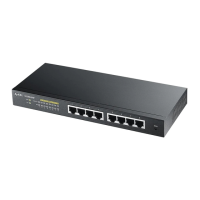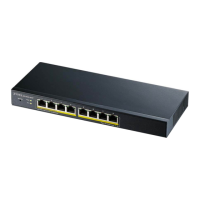GS1920 Series User’s Guide
316
CHAPTER 37
ARP Setup
37.1 ARP Overview
Address Resolution Protocol (ARP) is a protocol for mapping an Internet Protocol address (IP
address) to a physical machine address, also known as a Media Access Control or MAC address, on
the local area network.
An IP (version 4) address is 32 bits long. In an Ethernet LAN, MAC addresses are 48 bits long. The
ARP table maintains an association between each MAC address and its corresponding IP address.
37.1.1 What You Can Do
Use the ARP Learning screen (Section 37.2.1 on page 318) to configure ARP learning mode on a
per-port basis.
37.1.2 What You Need to Know
Read on for concepts on ARP that can help you configure the screen in this chapter.
37.1.2.1 How ARP Works
When an incoming packet destined for a host device on a local area network arrives at the Switch,
the Switch looks in the ARP Table and if it finds the address, it sends it to the device.
If no entry is found for the IP address, ARP broadcasts the request to all the devices on the LAN.
The Switch fills in its own MAC and IP address in the sender address fields, and puts the known IP
address of the target in the target IP address field. In addition, the Switch puts all ones in the
target MAC field (FF.FF.FF.FF.FF.FF is the Ethernet broadcast address). The replying device (which is
either the IP address of the device being sought or the router that knows the way) replaces the
broadcast address with the target's MAC address, swaps the sender and target pairs, and unicasts
the answer directly back to the requesting machine. ARP updates the ARP Table for future reference
and then sends the packet to the MAC address that replied.
37.1.2.2 ARP Learning Mode
The Switch supports three ARP learning modes: ARP-Reply, Gratuitous-ARP, and ARP-Request.
ARP-Reply
The Switch in ARP-Reply learning mode updates the ARP table only with the ARP replies to the ARP
requests sent by the Switch. This can help prevent ARP spoofing.
In the following example, the Switch does not have IP address and MAC address mapping
information for hosts A and B in its ARP table, and host A wants to ping host B. Host A sends an

